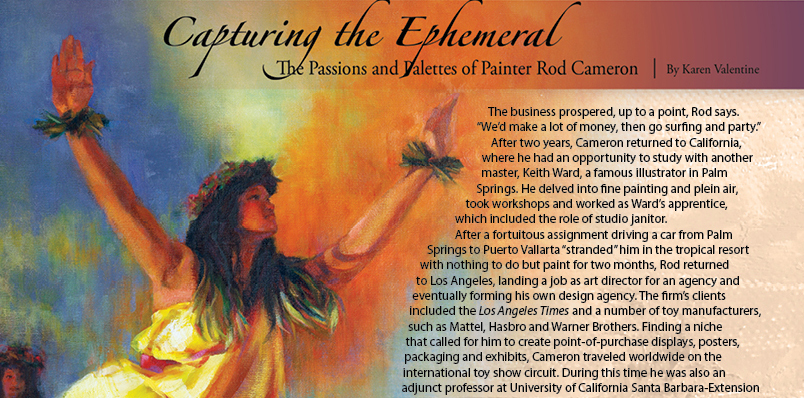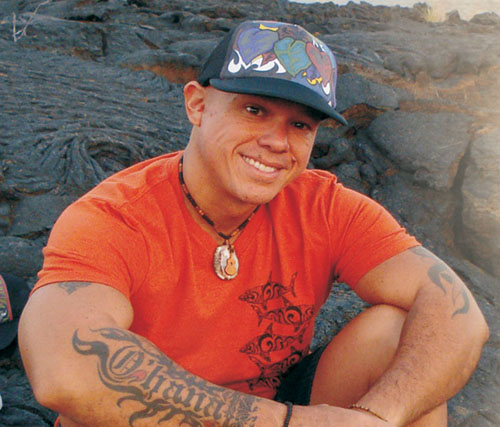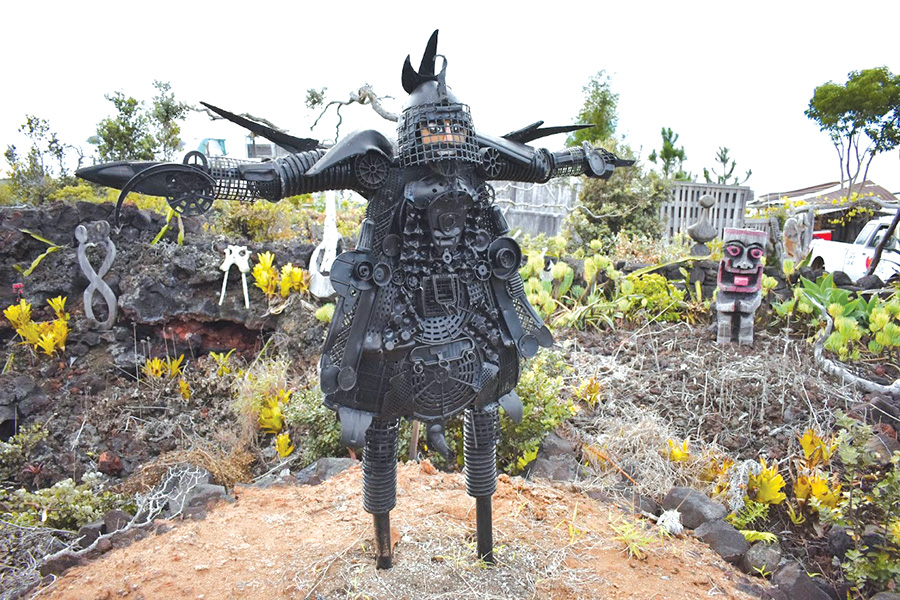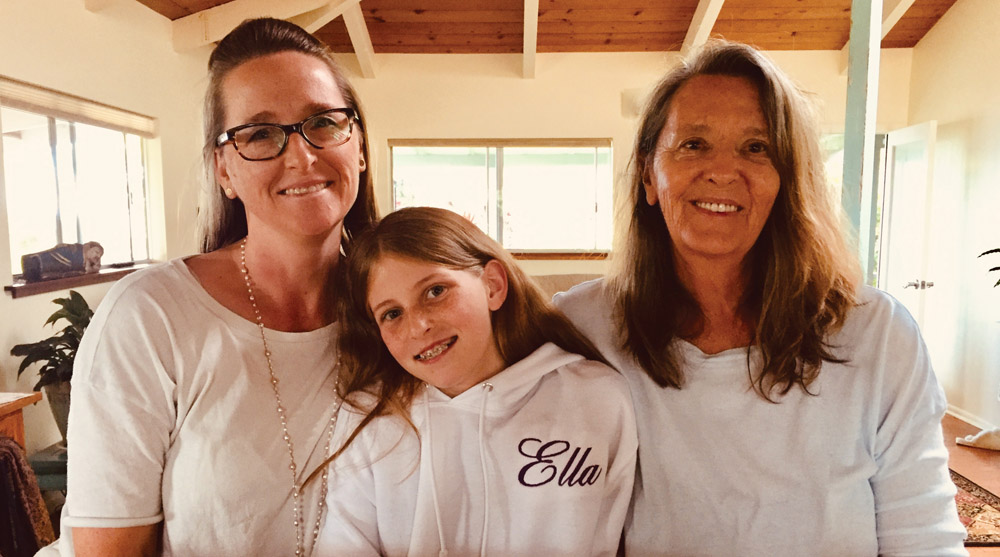
Capturing the Ephemeral: The Passions and Palettes of Painter Rod Cameron

By Karen Valentine
The eight-year-old boy stood, transfixed, as the rest of his friends ran ahead during their tour of Forest Lawn Memorial Park in Glendale, California. They turned around, worried about young Rod Cameron. The object of his fascination? The fold of skin over the hand of the Madonna, placed under the arm of the body of Jesus, in a marble replica of Michelangelo’s Pieta. That fine detail struck the young man as “some kind of genius.”
“From that moment, I was inspired to be an artist,” Rod says. Years later, with a multi-layered career behind him, the accomplished artist Rod Cameron displayed his dry, laconic sense of humor while sitting in his sunny Beach Road Studio in Hawaiian Paradise Park. With a totally deadpan face and only a twinkle in his eye, he joked, “That fella caught my eye. I thought, this guy’s got the talent!”
With the inspiration of no less than perhaps the greatest artist who ever lived, Cameron’s life path was illuminated for him as a painter who has never stopped exploring the depths and heights to which color and light may take him.
For the second year, he has been invited to create the image for the annual Merrie Monarch hula festival poster. It’s fitting perhaps that this festival poster commission should come not too long after his return to Hawai‘i, mirroring his first commercial art project in Hawai‘i, back in the ‘70s—t-shirts and flyers for another festival, the first Diamondhead Crater Music Festival.
Hawai‘i called to Cameron soon after finishing his college art studies in Southern California. A buddy who had returned from Vietnam with silk-screening skills invited Rod to come to O‘ahu to be partner in a t-shirt business. They obtained the design rights for the music festival and had the time of their lives, working day and night, but also being in the center of the “Hawaiian Woodstock” music scene with the most popular ‘70s entertainers of the day.
The business prospered, up to a point, Rod says. “We’d make a lot of money, then go surfing and party.”
After two years, Cameron returned to California, where he had an opportunity to study with another master, Keith Ward, a famous illustrator in Palm Springs. He delved into fine painting and plein air, took workshops and worked as Ward’s apprentice, which included the role of studio janitor.
After a fortuitous assignment driving a car from Palm Springs to Puerto Vallarta “stranded” him in the tropical resort with nothing to do but paint for two months, Rod returned to Los Angeles, landing a job as art director for an agency and eventually forming his own design agency. The firm’s clients included the Los Angeles Times and a number of toy manufacturers, such as Mattel, Hasbro and Warner Brothers. Finding a niche that called for him to create point-of-purchase displays, posters, packaging and exhibits, Cameron traveled worldwide on the international toy show circuit. During this time he was also an adjunct professor at University of California Santa Barbara-Extension and illustrated over a dozen children’s books. He has been honored with more than 60 awards for art, illustration and design; including a National Ben Franklin Gold and two Silver Awards for the books.
Still nurturing a dream to some day return to Hawai‘i, Cameron was thinking of a way to fund his move. The answer came in the realization that toy inventors earn royalties that create an ongoing stream of income. So he came up with a marketable idea in bubble blowers that don’t need a bottle of soap to make the bubbles. They just dip in water—much less mess.
Throughout Cameron’s commercial art career that spanned the transition from drawing board to computer, he never left his core talents in hand illustration, using the media of airbrush, gouache and pen and ink to render his projects. And, he never lost his passion for painting like the masters did, in oils.
“I like the malleability of the paint. It takes awhile to dry, so you can keep working it. I build up layers that I call veils of color.” In addition to Michelangelo and the Impressionists, Cameron’s inspirational artists include John Singer Sargent and Lucien Freud (grandson of Sigmund Freud). All are proficient in rendering the human figure and portraiture.
“I always return to the figure,” says Cameron, “because in the body you have all the elements of nature—the hills and valleys and colors.”
All the forces of nature have led him to his latest passion—painting the ephemeral landscape of the volcano and most specifically, the dancers who interpret it in the ancient kahiko style of hula.
As a plein air painter, Cameron is adept at painting outdoor landscapes. Sometimes, however, he has to simulate the atmosphere in the studio. This he has done in recreating the glow of the volcano casting its light upon the hula dancer.
“For an artist, being able to paint with the light source coming out of the ground—that’s just the most amazing thing,” Cameron says. A raised platform or stage puts his model at a level where the painter’s eye is at “ground level.” Professional lighting with colored gels casts the red and yellow colors that distinguish his paintings.
Kumu Hula Ehulani Stephany and Halau Hula Ka Makani Hali ‘Ala O Puna, of Nanawale have become collaborators with Cameron in providing models, costumes and background accompaniment for his Merrie Monarch poster paintings.
After watching a performance by the halau at an art show opening at Pahoa Museum, he asked the kumu if she could help provide models for his paintings. She graciously agreed and introduced him to the wahine and kane models that would become inspirations for the past two years’ posters. Kau‘ilani Quihano posed for the 2010 image and Kuane‘omea Cariaga was the kane inspiration for this year’s poster.
Kumu Ehulani —who also appears in the background of 2011 poster art—led them through the authentic Pele (volcano) dances on his special studio stage. Along the way, she also consulted with the artist to assure the appropriateness of the dancers’ positions for the paintings.
A misty, veiled atmosphere of reds, yellows and oranges surrounds the dancers in traditional Pele dance regalia as they portray the stories of the volcano, seen reflected in their eyes.
Kumu Ehulani says Cameron is “getting more and more inspired by the spirit of our living volcano and I can see it in him.”
“There’s such an ancient, almost primordial atmosphere here that is unique to anywhere else in the world,” says Cameron, whose passion about this phase of his painting career is evident. “I’m not a commercial illustrator anymore. I’m not interested in portraying the hula dancer in the romantic style. I want to be true to the authentic hula and to everything I paint.” It’s not important for his dancers, for example, to have thin, models’ figures, he says.
Watch for the painter, with Kumu Ehulani and her dancers, who will be riding on a float in the 2011 Merrie Monarch Festival Parade on Saturday, April 30, in downtown Hilo.
Cameron is now preparing for a show at the Volcano Art Center Gallery, “Colors of a Living Volcano,” opening March 12. The paintings are still in process as this article is written. “Every show I do has a certain amount of experimentation. I’ll try different things.“ He works at different sites around Hawai‘i Volcanoes National Park and says he’ll work right up until the show opens. “I like doing a show that is site-specific, and there’s so much in one place with the volcano. The range of colors and subjects is phenomenal. I want to paint in a zone, night and day. The beauty of immersing oneself into an area like this is that you start dreaming it.”
Since the time he was eight years old, Cameron has taught himself art techniques, and after formal training, he is still learning. “I am now in a phase experimenting with the Fibonacci sequence,” he says. It’s a mathematical proportion that applies to the relationships of parts in most everything in nature—seashells, flowers, animals and the proportions in the human body. An extension of this learning is the exploration of the Japanese proportional rectangle, Cameron says.
Rod Cameron the painter is now, also, Rod Cameron the teacher, conducting a schedule of workshops. On April 16, he will be teaching a workshop in figurative painting with a live hula model at Volcano Art Center, Niulani. Then, in May, he will host a painters’ tour to Prague, Czech Republic, featuring a five-day plein air workshop and touring. Prague is a city with many attractive scenes and beautiful, historic buildings to intrigue the artists, he says. He will be accompanied by friends, artist Margaret Stanton and guide and interpretor Maj Jiri Baleg, who has lived there since before the “Velvet Revolution,” and knows the city from the inside.
Mixing his love for the “old world” scenes with his passion for primordial landscapes in formation, Cameron has a full palette of colors and subjects from which to draw.
Contact Rod: 808.982.8428


